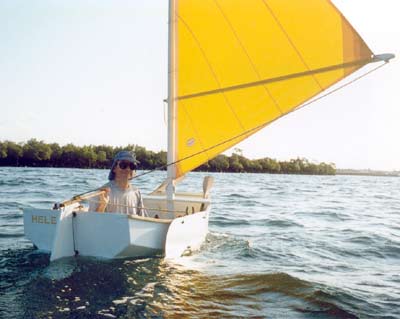Forget About Thinking
I’ve preached long and hard about building boats that
are smaller than you think you really need. The problem is the
thinking bit. Perhaps we should concentrate on the need part,
and cut out the thinking!
For a good part of my life, I have devoured books on boat design
and construction, along with countless plans catalogues. This
reading business is a bitter/sweet pill – It has given
me information from teachers I’ve never met, many of whom
were dead before I learned to read. Reading their work has allowed
me to gain information that would have taken me many lifetimes
to discover on my own. I have been able to stand on the shoulders
of those who have been there before. That is the sweet part.
The bitter part is that reading makes me think, and thinking
prevents me from doing!
There is a familiar pattern to my reading. I get an idea, which
in turn sends me in search of a book for more information. Searching
for the information is almost always destructive, because I
find out too much. Too many other designs, or too many other
construction methods, or too many potential problems, and so
on.
An associated problem is when I settle on a design which would
be perfect…if it was just a little bigger, or had just
a bit more sail, or was built using a slightly different method
etc etc. Once again the culprit is too much thought.
I’m sure that there is no way to prevent this thought-trap
process completely, but it helps to be aware of its dangers.
In my case the primary danger is getting nothing done because
there are too many options, too many designs, too many problems.

But there is a solution. Forget about thinking, and just follow
your gut feelings, always going for a design that is smaller
and simpler than you think that you need. Once you start building,
the job itself will answer most of the hundreds of questions,
which clog up your mind when reading. The majority of the problems
don’t ever eventuate, and the ones that do get you, are
ones that you had not thought of anyway!
This is not to say that thinking is a bad thing. Some of my
best friends think. It is just that the interval between thought
and action should be reduced to the absolute minimum. Think
about what you are doing as you are building, or designing,
or painting, or using the boat. The end result stands a very
good chance of being satisfying.

Models
For those who are badly infected with the boatbuilding bug,
one of the most effective learning techniques is to build models.
I have built dozens of models, some being complete in all detail,
and some being plain hulls to test panel developments. Between
the two extremes are many compromise models.
Models provide the astute builder with a wealth of information
about the proposed boat. Sheet usage, panel development, displacement,
trim, effect of loading, to name just a few. The most important
function of the model is to provide a three-dimensional view
of the design, which I find to be superior to computer-generated
perspectives.
I make up little bags of lead shot which are carefully weighed
to represent scale weights of people, outboards, stores, fuel
and so on. By viewing the floating model before and after adding
the shot-bags, accurate trim and stability information is instantly
provided. One has to remember that the weight increases or decreases
according to the cube of the linear scale. For example, a 1/8th
scale model needs representative weights to be 1/512th of the
full sized article.
My models hang around the workshop for years, piled on shelves
or lying on bench tops. They lie in ambush, catching your eye
as you walk past on other missions. Visitors look at them and
ask questions – I once sold a full-sized boat because
a customer casually picked up the model while discussing something
else altogether.
Because they sit in the background, their presence works on
the subconscious.
I have three sons, and they have used a selection of my models
as fully rigged sailing and powered versions. In the process
I’ve picked up valuable insights into the behavior of
differing hull forms in waves. There have been some remarkable
voyages. A one eighth scale model of Phil Bolger’s Diablo,
powered by a 0.5cc diesel, got away one day. She disappeared
over the horizon while heading out into Moreton Bay on a choppy
day. I gave chase in a clinker canoe and was lucky to locate
her two kilometres offshore, where she was floating happily
with an empty fuel tank. Relatively, the waves were enormous,
but the open boat contained only an eggcup of water. There have
been similar long voyages completed by some of the sailing models.
At Wynnum, we are lucky enough to have access to a 100 metre-long
salt-water wading pool. I have tested the relative resistance
of models by towing them around the edge of the pool, with two
boats attached to a yoke. The yoke is made of light plywood
and the towline of each model is attached to one or other of
the extremities. The information provided is not absolute, but
it is easy to gain excellent relative resistance data.
Sometimes it is better to stop thinking and start playing.
Build simply and modestly and enjoy the journey.

